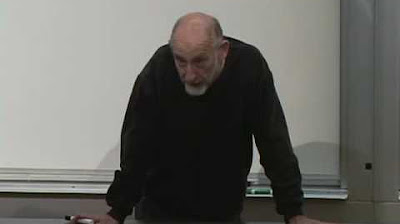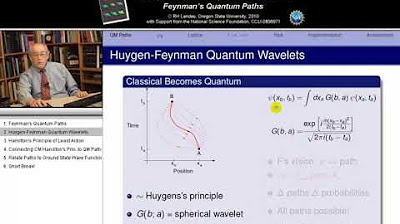What Happens Inside a Proton?
TLDRThe video script delves into the complexities of simulating a universe at the quantum level, highlighting the challenges of calculating the behavior of atomic nuclei due to the intricate interactions of quarks and gluons. It introduces lattice Quantum Chromodynamics (QCD) as a method to overcome these challenges by simulating quantum fields on a discrete spacetime lattice. The script explains how this approach, combined with Monte Carlo sampling and the Wick rotation, allows for the calculation of probabilities and the evolution of quantum fields, leading to accurate predictions of particle properties and interactions. The success of lattice QCD in predicting various aspects of subatomic physics is emphasized, showcasing its importance in understanding the fundamental forces and particles that make up our universe.
Takeaways
- 🌌 The complexity of simulating a universe starts with understanding the atomic nucleus, which requires immense ingenuity due to the underlying quantum mechanics.
- 📈 Physics relies on mathematical equations to predict the behavior of the universe, but solving these equations perfectly is a challenge, especially for complex systems.
- 🤖 Density functional theory (DFT) is a method used to simulate electron behavior in atoms, but it simplifies the complex interactions within atomic nuclei.
- 🔵 Quantum chromodynamics (QCD) describes the interactions of quarks and gluons, which is more complex than quantum electrodynamics (QED) due to the strong force.
- 🎨 Feynman diagrams help visualize particle interactions, but they become impractical for QCD due to the vast number of possible interactions and high complexity.
- 🔄 Lattice simulations are used to model quantum fields in QCD, transforming the problem into a classical one that can be handled by statistical mechanics.
- 🕒 The Wick rotation is a key technique in lattice QCD that treats time as another dimension, simplifying the complex phase shifts in the simulations.
- 🔢 Monte Carlo sampling is employed in lattice QCD to randomly select field configurations, which helps in approximating the probability of interactions.
- 🔍 Lattice QCD has been successful in predicting properties of hadrons and understanding quark-gluon plasma, showcasing the power of computational physics.
- 🌐 The lattice model, while an approximation, can yield accurate results when the pixel size is varied, allowing for the extraction of meaningful physical quantities.
- 🚀 As computational power advances, the potential for detailed simulations of subatomic particles and their interactions improves, enhancing our understanding of the quantum world.
Q & A
What is the main challenge in simulating a universe?
-The main challenge in simulating a universe lies in the complexity of calculating the evolution of even the simplest systems, especially when it comes to quantum mechanics, where the information density is extremely high.
How do the laws of physics help us understand the universe?
-The laws of physics, which often take the form of mathematical equations, allow us to make predictions about how the universe should behave. This enables us to test our theories and manipulate the foundations of reality to some extent.
What is Quantum Chromodynamics (QCD)?
-Quantum Chromodynamics (QCD) is the theory that describes the interactions of quarks and gluons, which are the fundamental constituents of protons and neutrons. It is a key component of the Standard Model of particle physics.
What is the role of quarks and gluons in the atomic nucleus?
-Quarks and gluons are the building blocks of protons and neutrons, which together form the atomic nucleus. The interactions among these particles, described by QCD, are responsible for the strong nuclear force that holds the nucleus together.
Why are Feynman diagrams insufficient for simulating Quantum Chromodynamics?
-Feynman diagrams are insufficient for simulating QCD because the strong force, which is mediated by gluons, is much stronger than the electromagnetic force. This results in a vast number of possible interactions that cannot be effectively calculated using pen and paper or even with the help of computers using the Feynman diagram approach.
What is lattice QCD and how does it help in simulating quantum fields?
-Lattice QCD is a computational approach that models the quantum fields themselves, rather than using virtual particles. It involves discretizing spacetime into a lattice and using statistical mechanics to simulate how the lattice evolves over time, which helps in overcoming the computational challenges posed by QCD.
How does the Monte Carlo sampling method contribute to lattice QCD simulations?
-Monte Carlo sampling is a computational method that involves randomized selections from a distribution. In the context of lattice QCD, it is used to randomly choose a selection of field configurations that represent possible paths between the starting and final states of a quantum field, which helps in calculating the probability of a given interaction.
What is the significance of the Wick rotation in lattice QCD?
-The Wick rotation is a mathematical technique used in lattice QCD to transform the problem of simulating quantum fields into a classical problem. By treating time as another dimension of space, it eliminates the complex nature of phase shifts, making the simulation more manageable.
How does lattice QCD help us understand the nature of quantum fields?
-Lattice QCD provides insights into the nature of quantum fields by simulating them directly, rather than relying on the concept of virtual particles. This approach helps clarify that virtual particles are merely an approximation of the actual behavior of quantum fields during an interaction.
What are some applications of lattice QCD in particle physics?
-Lattice QCD has been used to accurately predict various properties of hadrons, such as their masses and decay frequencies, and to study the properties of quark-gluon plasma. It has also played a crucial role in the analysis of experimental results, such as the new muon g-2 measurements.
How does the concept of spacetime discretization affect the results of lattice QCD simulations?
-The discretization of spacetime in lattice QCD is an approximation that simplifies the computation. However, the results of the simulation, such as the mass of a hadron, do depend on the choice of pixel size. By running simulations for different lattice spacings, researchers can determine the relationship between the pixel size and the physical quantity of interest, ultimately allowing them to extrapolate to the case of continuous spacetime.
Outlines
🌌 Simulating the Microcosmic Universe
This paragraph introduces the concept of simulating a universe at the smallest scale, specifically focusing on atomic nuclei. It emphasizes the complexity of such a task due to the intricate interactions within the quantum world. The paragraph explains how physics uses mathematical equations to predict the behavior of the universe, but the challenge lies in solving these equations for complex systems. The discussion moves to quantum chromodynamics (QCD), which describes the interactions of quarks and gluons, and the difficulty in calculating the behavior of these subatomic particles due to the strong force. The paragraph sets the stage for the introduction of lattice simulations as a potential solution to these computational challenges.
🔬 Quantum Electrodynamics and the Strong Force
The second paragraph delves into the specifics of quantum electrodynamics (QED) and the strong force, comparing their computational challenges. It explains the fine structure constant and its role in the electromagnetic interaction, and contrasts it with the strong coupling constant, which is much larger and makes calculations much more difficult. The paragraph highlights the limitations of using Feynman diagrams for QCD due to the vast number of possible interactions and the strong force's complexity. It suggests that a different approach is needed to understand and test QCD, leading into the discussion of lattice QCD and its potential to model quantum fields more directly.
🧠 Lattice QCD: A Computational Hack for Quantum Fields
This paragraph explains the methodology of lattice QCD, a computational approach to simulating quantum fields. It addresses the challenges of simulating quantum fields due to the infinite number of possible configurations and the complexity of integrating these fields. The paragraph introduces Monte Carlo sampling as a method to handle the vast number of field configurations and the Wick rotation, which transforms the problem into a classical one by treating time as another dimension. This allows the use of statistical mechanics to simulate the evolution of the lattice, providing insights into the nature of quantum fields and enabling accurate predictions of hadron properties and other phenomena.
🤝 Community and Corrections: A Platform for Learning
The final paragraph shifts focus from the technical aspects of quantum simulations to the community engagement and corrections. It acknowledges the support from Patreon and the benefits for contributors, including access to a Discord server and episode scripts. The paragraph also addresses corrections and discussions from previous episodes, such as the definition of absolute zero temperature and the concept of superdeterminism. It highlights the importance of community interaction in the learning process and the ongoing exploration of complex scientific concepts.
Mindmap
Keywords
💡Simulation
💡Quantum Chromodynamics (QCD)
💡Quarks
💡Gluons
💡Lattice QCD
💡Feynman Diagrams
💡Monte Carlo Sampling
💡Wick Rotation
💡Hadrons
💡Strong Force
💡Quantum Field
Highlights
The necessity of simulating a single atomic nucleus before attempting to simulate an entire universe.
The success of physics in discovering the mathematical rules governing the universe.
The challenge of solving equations for complex systems due to the high information density in the quantum world.
The concept of density functional theory (DFT) as a hack to simulate electron behavior in atoms.
The complexity of simulating the behavior of quarks and gluons within atomic nuclei.
The description of quarks as a roiling, shifting swarm of virtual quarks and gluons.
The introduction of quantum chromodynamics (QCD) as the theory describing the interactions of quarks via gluons.
The problem of testing QCD due to the strong force's interior maelstrom of activity.
The clever use of lattice simulations to overcome the computational challenges of QCD.
The comparison between quantum electrodynamics (QED) and QCD, highlighting the differences in their complexities.
The explanation of Feynman diagrams and their role in calculating probabilities for particle interactions.
The significance of the fine structure constant and its impact on the electromagnetic interaction's relative weakness.
The difficulty in calculating strong force interactions due to the high strong coupling constant.
The concept of asymptotic freedom as an exception where strong coupling constant becomes small.
The transition from Feynman diagrams to a more direct modeling of quantum fields in lattice QCD.
The use of the Feynman path integral as a basis for calculating probabilities in quantum field theory.
The method of Monte Carlo sampling as a computational trick to handle complex field configurations.
The Wick rotation as a technique to transform quantum fields into a classical crystal-like structure.
The lattice QCD's ability to accurately predict properties of hadrons and its contribution to understanding quantum fields.
The potential of lattice QCD simulations to contribute to our understanding of tiny patches of spacetime.
Transcripts
Browse More Related Video

Lecture 2 | New Revolutions in Particle Physics: Standard Model

Lecture 4 | New Revolutions in Particle Physics: Standard Model

17.8 Feynman Quantum Path Integrals II

All Fundamental Forces and Particles Explained Simply | Elementary particles

Lecture 2: Experimental Facts of Life

17.7 Feynman Quantum Path Integrals I
5.0 / 5 (0 votes)
Thanks for rating: